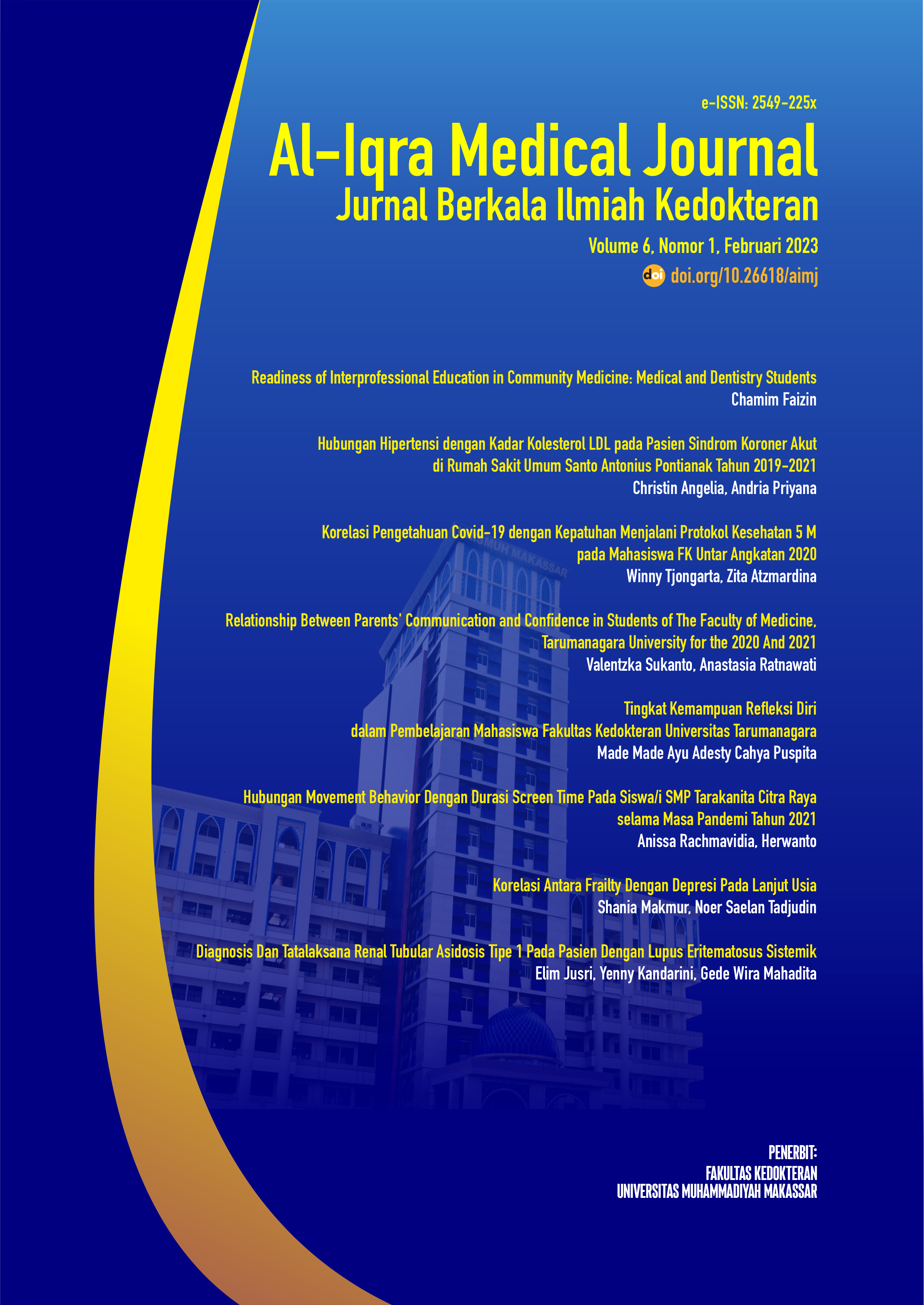READINESS OF INTERPROFESSIONAL EDUCATION IN COMMUNITY MEDICINE: MEDICAL AND DENTISTRY STUDENTS
DOI:
https://doi.org/10.26618/aimj.v6i1.9285Keywords:
readiness, interprofessional education, community medicine, medical students, dental studentsAbstract
Abstract
The condition of public health is a reflection of the level of complexity of health problems. Many health care systems have innovated but failed in the practice of collaboration, teamwork, and communication. Family-based care will ease the workload of doctors and improve the level of health for patients in the community. Interprofessional education program was designed to increase of collaborative practice and teamwork among health team. This review aims to analyze the readiness of interprofessional education (IPE) in medical and dentistry students in collaborative field practice community medicine with a family approach. Quantitative methods using cross sectional with the readiness interprofessional learning scale (RIPLS). Total sampling with 142 medical students and 43 dental students carried out collaborative practice on 16 families to find priority health problems and carry out preventive interventions. The average readiness of interprofessional education descriptively for students is 65.36% (range 50%-76%). 100% student ready for interprofessional education. No difference among medical and dentistry student in readiness of interprofessional education with p value 0,810 (>0,05). That all student ready to interprofessional education community medicine with family approach. Key words : readiness, interprofessional education, community medicine, medical students, dental studentsReferences
Herath C, et.al. comparative study of interprofessional education in global health care: A systematic review. Med (United States). 2017;96(38).
Khalili H. Online interprofessional education during and post the COVID-19 pandemic: a commentary. J Interprof Care [Internet]. 2020;34(5):687–90. Available from: https://doi.org/10.1080/13561820.2020.1792424
Homeyer S,. et.al. Effects of interprofessional education for medical and nursing students: Enablers, barriers and expectations for optimizing future interprofessional collaboration - a qualitative study. BMC Nurs. 2018;17(1):1–10.
Alzamil H, Meo SA. Medical students’ readiness and perceptions about interprofessional education: A cross sectional study. Pakistan J Med Sci. 2020;36(4):693–8.
Davidson JE. Guidelines for Family-Centered Care in the Neonatal, Pediatric, and Adult ICU. Crit Care Med. 2017;45(8):1352–8.
Meleis AI. Interprofessional Education: A Summary of Reports and Barriers to Recommendations. J Nurs Scholarsh. 2016;48(1):106–12.
Yousuf Guraya S, Barr H. The effectiveness of interprofessional education in healthcare: A systematic review and meta-analysis ScienceDirect. Kaohsiung J Med Sci [Internet]. 2018;34:160–5. Available from: http://creativecommons.org/licenses/by-nc-nd/4.0/
Sulaiman N, et al. A mixed methods approach to determine the climate of interprofessional education among medical and health sciences students. BMC Med Educ. 2021;21(1):1–13.
Zanotti R, Sartor G, Canova C. Effectiveness of interprofessional education by on-field training for medical students, with a pre-post design. BMC Med Educ. 2015;15(1):1–8.
Danielson J, Willgerodt M. Building a theoretically grounded curricular framework for successful interprofessional education. Am J Pharm Educ. 2018;82(10):1133–9.
Bodenheimer T, Sinsky C. From triple to Quadruple Aim: Care of the patient requires care of the provider. Ann Fam Med. 2014;12(6):573–6.
Eggenberger T, Millender E, Drowos J, France NEM. Interprofessional education and practice guide: Developing interprofessional community-based clinical experiences. Cogent Med [Internet]. 2019;6(1):1676582. Available from: https://doi.org/10.1080/2331205X.2019.1676582
Morris D, Matthews J. Communication, respect, and leadership: Interprofessional collaboration in hospitals of rural Ontario. Can J Diet Pract Res. 2014;75(4):173–9.
Spencer J, Woodroffe J, Cross M, Allen P. “a golden opportunity”: Exploring interprofessional learning and practice in rural clinical settings. J Interprof Care. 2015;29(4):389–91.
Thompson S, Metcalfe K, Boncey K, Merriman C, Flynn LC, Alg GS, et al. Interprofessional education in geriatric medicine: Towards best practice. A controlled before-after study of medical and nursing students. BMJ Open. 2020;10(1):1–14.
Tyastuti D, Onishi H, Ekayanti F, Kitamura K. Psychometric item analysis and validation of the Indonesian version of the Readiness for Interprofessional Learning Scale (RIPLS). J Interprof Care. 2014;28(5):426–32.
Susanti E. HUBUNGAN TINGKAT PENGETAHUAN DENGAN KESIAPAN MAHASISWA FKIK UNIVERSITAS MUHAMMADIYAH YOGYAKARTA MENGHADAPI INTERPROFESIONAL EDUCATION (IPE). Repos UMY [Internet]. 2015;151:10–7. Available from: http://etd.umy.ac.id/id/eprint/28024/
A’la, Muhammad Zulfatul; et.al. PERSEPSI DAN KESIAPAN MAHASISWA TAHAP AKADEMIK TERHADAP INTERPROFESSIONAL EDUCATION DI FAKULTAS KEDOKTERAN UNIVERSITAS GAJAH MADA. Indones J Heal Sci. 2012;2(2):184–97.
Rahmadayani E, Wardani NP, Sudira PG. Pengaruh Jumlah Pembekalan terhadap Persepsi dan Kesiapan Mahasiswa Mengenai Interprofessional Education di Universitas Udayana. J Med Udayana [Internet]. 2020;9(11):80–4. Available from: https://ojs.unud.ac.id/index.php/eum/article/view/71024/38658
Hadira. Persepsi dengan Kesiapan Mahasiswa Menghadapi Interprofesional Education (IPE) di Fakultas Kedokteran dan Ilmu Kesehatan UIN Alauddin Makassar. Repos UIN Alaudin Makasar [Internet]. 2021; Available from: http://repositori.uin-alauddin.ac.id/id/eprint/20020
Akhmad VS. Hubungan Efikasi Diri dengan Kesiapan Interprofesional Education (IPE) pada Mahasiswa Fakultas Kedokteran dan Ilmu Kesehatan (FKIK) UIN Alauddin Makassar. Repos UIN Alaudin Makasar [Internet]. 2017;1–14. Available from: http://repositori.uin-alauddin.ac.id/id/eprint/4160
Luh N, Widiawati A, Ketut N, Mirayati A. HUBUNGAN TIPE KEPRIBADIAN DENGAN KESIAPAN INTERPROFESIONAL EDUCATION ( IPE ) PADA MAHASISWA KESEHATAN DI STIKES WIRA MEDIKA BALI The Personality Types relations with Interprofessional Education ( IPE ) Readiness for Health Students at STIKes Wira Medika B. Repos Stikes Wira Med [Internet]. 2020;1–11. Available from: http://repository.stikeswiramedika.ac.id/id/eprint/55
Numasawa Id M, et al. A mixed methods study on the readiness of dental, medical, and nursing students for interprofessional learning. 2021; Available from: https://doi.org/10.1371/journal.pone.0255086
Ahmad MI, et.al. Are first-year healthcare undergraduates at an Asian university ready for interprofessional education? J Interprof Care. 2013;27(4):341–3.

